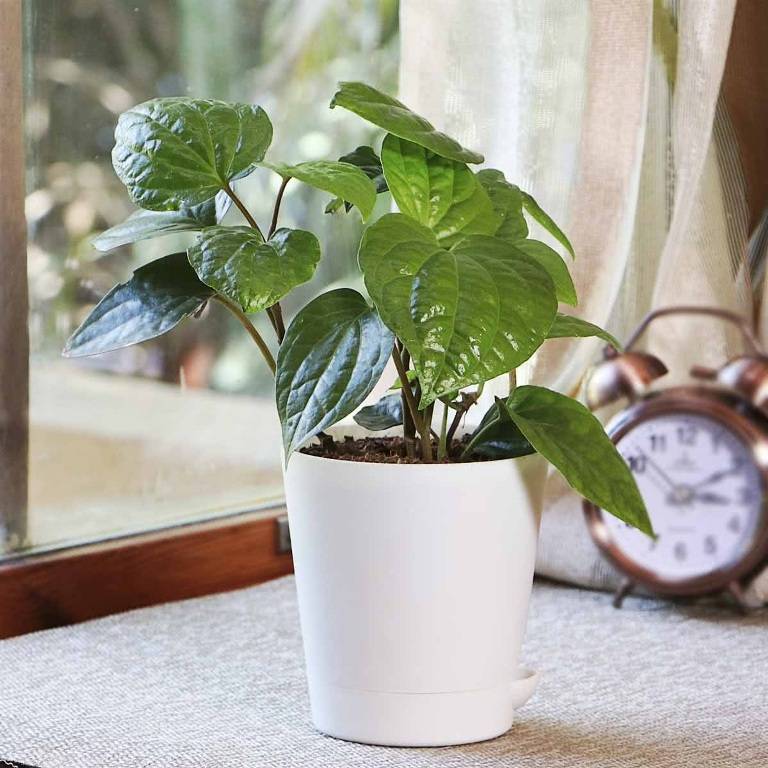
The organic name of the betel plant is Piper betle. It is local to India, and the leaves of this plant have been utilized as a mouth freshener in the nation since long back. Betel plants fall in the category of vine creepers and need some help as they cannot uphold their weight. This herb can be grown in pots, in your balcony or indoors with partial sunlight.
Commonly known as: Paan, Nagar-bel, Vettila, Khavyache-pan, Naagavaela etc.
India and Betel (Paan) significance:
Paan leaves and Indian customs go hand in hand; the leaves are traditionally used in different auspicious celebrations like wedding ceremonies, and so on. Also, it is a well known delicacy all over the country, often eaten after dinners to help digestion. Pretty much every Indian has savored its delicacy once in the course of their life. Ayurveda records an assortment of paan leave usage in the treatment of numerous ailments too.
Paan growing states in India:
Major tropical and subtropical regions of India that are the main cultivators of paan include:
- Assam
- Andhra Pradesh
- West Bengal
- Rajasthan
- Bihar
- Madhya Pradesh
- Kerala
- Karnataka
Nearly 80 percent of the production comes from states of Assam, Kerala and Karnataka.
Subsidies offered by Govt:
The Horticulture department confirms that a project to include betel in horticulture was sent to the finance department three years ago. Also if the project comes through, farmers will be able to get subsidy and benefits of other government schemes for betel farming,
Let's learn about how you can grow this plant in your house.
If you belong to a cold region in India like Himachal Pradesh, Uttrakhand, Kashmir, and Sikkim, move your plant indoors in the winter season to avoid snowfall. On the other hand, if you are native to a hotter region like Rajasthan, extra special care is required in the summers. Shade from a cloth and frequent watering will be enough.
Betel plants can be grown in pots and containers and can be grown around the year. Let’s check the different requirement for cultivation:
- Soil requirement:
In spite of the fact that paan plants can develop in a wide scope of soils, loam soil is ideal for its development. Prefer to go for a deep pot instead of a wide one. Put holes in the bottom of the pot for proper drainage of water. You can likewise include some sand in the dirt on the off chance that you are managing clayey soil.
- Water and Sunlight requirements:
A Betel or Paan plant requires watering on a daily basis (may not require in the rainy days) and grows well in moist soil. Also proper drainage should be maintained to avoid problems such as root rot etc. due to excess water.
Betel plants favour a partial hot and humid atmosphere. A region with gentle shade is best; a few hours of brilliant morning sun will help the plant. Select an area that gets indirect daylight and stay away from those areas receiving intense afternoon sun.
- Propagation Technique:
Select any 14 to 15 centimeter long stem and slice at a 45 degree angle with the help of a blade. Remove all the leaves from the stem apart from the ones at the top. Take the step and put it in a glass jar full of water. Move the stem from the jar to a pot once roots start to appear. Don’t forget to change the water of the jar at a regular interval of time.
- Fertilizer requirements:
Betel plants in most of the times does not require any type of fertilizer and readily available compost and cow dung manure is enough.
- Pests and Disease management:
Red mites can influence the development of the plant, and they can be treated with custom made pesticides like a blend of fluid dish soap and water. Fungal infection is also common in the rainy season and can be avoided by reduction in watering.
Leaf blight causes black patches in the leaves and can be treated by removing the affected leaves from the plant.
- Pruning and Harvesting:
Pruning is not necessary if harvesting is done regularly. Harvesting can be started once the plant reaches a height of around 2 metres. Harvesting of leaves leads to growth of new tender ones.











